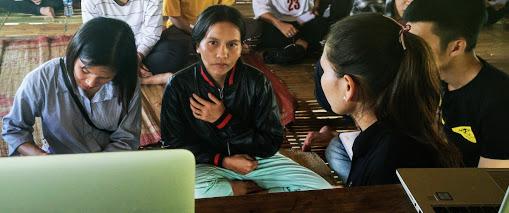Promoting Dignity Through Photovoice

The concept of dignity is at the core of DVINE-project. The definition of dignity ranges from universal human rights to a moral notion of respect for both oneself and others.
In his book “Respect. The Formation of Character in an Age of Inequality” American sociologist Richard Sennett notes that in our modern world respect is often earned either by being successful, having outstanding talents, gaining financial independence or by helping others.
Due to this logic, many service users in social and health care lack this kind of respect. Although the lack of respect, as Sennett notes, is not “an outright insult” it may still be as damaging and grave. The reason for this is that if one is not respected, he or she is not recognized, “not seen – as a full human being whose presence matters.” When most people are treated this way, without respect, without recognizing them, “it creates scarcity of respect”.
Sennet radically suggests that we are not able to reach respect only by eradicating inequalities, by committing ourselves to even distribution of resources, although these are extremely important goals. In addition, we also need to build respect on interpersonal level.
Sennett emphasizes that the idea of reciprocity distinguishes respect from its neighboring concepts such as status, prestige, or honor. Thus, the cornerstone of respect lies in the idea of mutuality. Respect means the capacity to accept in others what one cannot understand.
However, it does not occur only by commanding nor is it enough to voice the words “I respect you”. Instead, respect must be performed, it “requires expressive work”. Therefore, respect is not only about thoughts but also about deeds, about how you encounter other people, what words you use, how you involve or integrate e.g. social work clients into the work.
In his book, Sennett does not offer any practical policies for the welfare state. Nor does he provide any practical solutions on how to enhance mutual respect between e.g. workers and users of social and health care.
Photovoice Calls the Community Members to Participate
One possible way of promoting the expression of mutual respect is via a method called photovoice. The notion of mutual respect is, in fact, embedded in the idea of photovoice. Photovoice borrows from feminist theories, Freirean critical pedagogy, and documentary photography. It is often used with different types of communities, marginalized groups or with people who have only little, if any, influence in society, in other words with those, using Sennett’s expression, are not “seen as full human beings whose presence matters”.
As a community based participatory action research method, photovoice tries to deconstruct the traditional hierarchical positions of the researcher and those being researched. The community members participate in the research project right from the planning stage and are involved in the analysis stage as well.
Photovoice emphasizes the democratization of knowledge production process giving the community members a sense of ownership over the knowledge they produce. It acknowledges that community members have a deep understanding of their own communities which professionals cannot necessarily achieve. This kind of social layout is likely to increase mutual respect.
The implementation of photovoice, the field work, includes several steps. To begin with, the community members, after learning how to use cameras, take photos of their everyday life recording the strengths and needs of their community. These photos are then shared and critically discussed and analyzed in a group with other community members.
Finally, the photos, and narratives attached to them, are presented in a photo exhibition. The aim of the exhibition, and of photovoice itself, is to reach policymakers, engage them in discussions about the lives and conditions of community members. If the method is thoroughly followed photovoice offers a space not only for sharing ideas and collecting information but for mutual recognition as well.
Photovoice also gave the community members a voice and made it possible for them to be recognized as who they are. As one of the participants said: “This was the first time anyone wanted to listen to me, was interested in my story.”
Experiences from the Field
Due to the tight schedule during intensive courses of DVINE project in autumn 2019, the students were not able to implement full photovoice projects. However, they were able to apply few elements of the method in practice. This gave them an opportunity to reflect its potential use when promoting the expression of mutual respect.
During the process, the students became aware of the knowledge that the locals had e.g. about the environmental crisis and its impact on their everyday life. They acknowledged community members as resourceful individuals, respected them despite the differences in e.g. social rank.
Community members, on the other hand, gained self-respect. They expressed that they were proud of their photos. For some it was a first time to hold a camera in hand. The use of photovoice also helped to improve their self-confidence.
Photovoice also gave the community members a voice and made it possible for them to be recognized as who they are. As one of the participants said: “This was the first time anyone wanted to listen to me, was interested in my story.”
Thus, the photovoice method is a valuable tool for increasing mutual respect.
Sennett, R. 2003. Respect. The Formation of Character in an Age of Inequality. London: Penguin Books.
Writers:
Katja Päällysaho, Diak
Carolina Ohls, VID
Lauri Uljas, Diak
Photo: Katja Päällysaho
